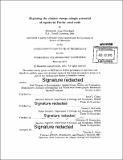| dc.contributor.advisor | Anne L. Cohen, Daniel C. McCorkle, and Kristopher B. Karnauskas. | en_US |
| dc.contributor.author | Drenkard, Elizabeth Joan | en_US |
| dc.contributor.other | Woods Hole Oceanographic Institution. | en_US |
| dc.coverage.spatial | p------ | en_US |
| dc.date.accessioned | 2015-06-10T19:11:22Z | |
| dc.date.available | 2015-06-10T19:11:22Z | |
| dc.date.copyright | 2015 | en_US |
| dc.date.issued | 2015 | en_US |
| dc.identifier.uri | http://hdl.handle.net/1721.1/97339 | |
| dc.description | Thesis: Ph. D., Joint Program in Oceanography/Applied Ocean Science and Engineering (Massachusetts Institute of Technology, Department of Earth, Atmospheric, and Planetary Sciences; and the Woods Hole Oceanographic Institution), 2015. | en_US |
| dc.description | Cataloged from PDF version of thesis. | en_US |
| dc.description | Includes bibliographical references. | en_US |
| dc.description.abstract | Global climate models project a 21st century strengthening of the Pacific Equatorial Undercurrent (EUC). The consequent increase in topographic upwelling of cool waters onto equatorial coral reef islands would mitigate warming locally and modulate the intensity of coral bleaching. However, EUC water is potentially more acidic and richer in dissolved inorganic nutrients (DIN), both widely considered detrimental to coral reef health. My analysis of the Simple Ocean Data Assimilation product indicates that the EUC has indeed strengthened over the past 130 years. This result provides an historical baseline and dynamical reference for future intensification. Additionally, I reared corals in laboratory experiments, co-manipulating food, light and CO2 (acidity) to test the role of nutrition in coral response to elevate CO2 conditions. Heterotrophy yields larger corals but CO2 sensitivity is independent of feeding. Conversely, factors that enhance zooxanthellate photosynthesis (light and DIN) reduce CO2 sensitivity. Corals under higher light also store more lipid but these reserves are not utilized to maintain calcification under elevated CO2 My results suggest that while mitigation of CO2 effects on calcification is not linked to energetic reserve, EUC fueled increases in DIN and productivity could reduce effects of elevated CO2 on coral calcification. | en_US |
| dc.description.statementofresponsibility | by Elizabeth Joan Drenkard. | en_US |
| dc.format.extent | 169 pages | en_US |
| dc.language.iso | eng | en_US |
| dc.publisher | Massachusetts Institute of Technology | en_US |
| dc.rights | M.I.T. theses are protected by copyright. They may be viewed from this source for any purpose, but reproduction or distribution in any format is prohibited without written permission. See provided URL for inquiries about permission. | en_US |
| dc.rights.uri | http://dspace.mit.edu/handle/1721.1/7582 | en_US |
| dc.subject | Joint Program in Oceanography/Applied Ocean Science and Engineering. | en_US |
| dc.subject | Earth, Atmospheric, and Planetary Sciences. | en_US |
| dc.subject | Woods Hole Oceanographic Institution. | en_US |
| dc.subject.lcsh | Coral bleaching | en_US |
| dc.subject.lcsh | Coral reef ecology | en_US |
| dc.title | Exploring the climate change refugia potential of equatorial Pacific coral reefs | en_US |
| dc.type | Thesis | en_US |
| dc.description.degree | Ph. D. | en_US |
| dc.contributor.department | Joint Program in Oceanography/Applied Ocean Science and Engineering | en_US |
| dc.contributor.department | Woods Hole Oceanographic Institution | en_US |
| dc.contributor.department | Massachusetts Institute of Technology. Department of Earth, Atmospheric, and Planetary Sciences | |
| dc.identifier.oclc | 910515468 | en_US |
